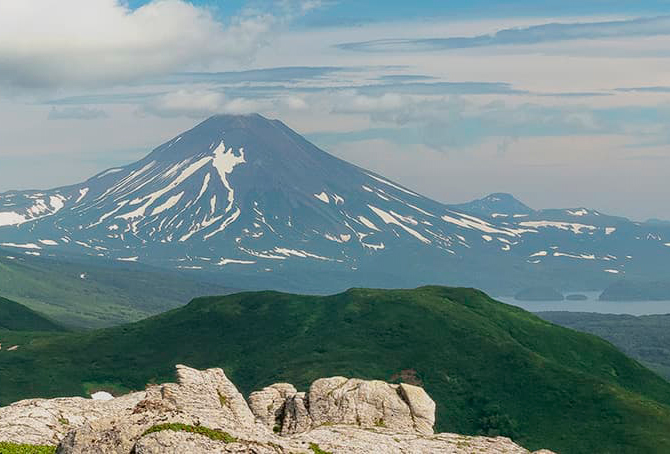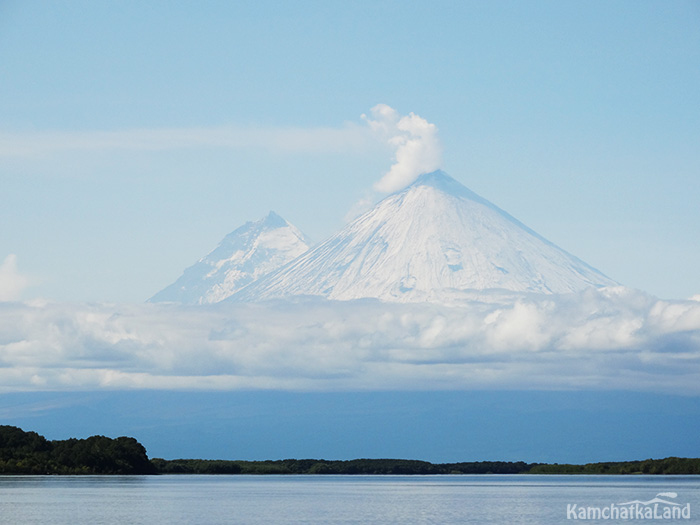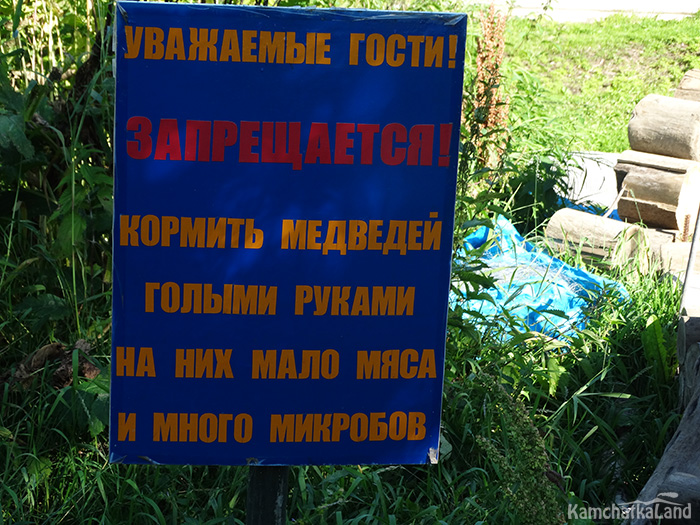
Lake Azhabachye
Lake Azhabachye is located in Kamchatka and is famous for the most active spawning of seals in the region. The lake is protected by the state, as the unique ecosystem formed here requires careful treatment.
The Azhabachye lake (also called Azabachye) adjoined to the Kamchatka river from the right side is one of the largest spawning bodies of water with red salmon (Asiatic nerka) in its basin. This is the third largest lake among other freshwater; it has an average depth of 18 meters. The lake was formed on the site of the ancient sea, so it has a relict formation background. At first itelmens (ethnic group) gave the name to the lake. It sounded like “azhabe” meaning “the month of the white (or silver) fish”.

The Azhabachye is surrounded by mountains, and located about 40 kilometers far away from the sea. The channel connects the lake and river. The Klyuchevskoy volcanic group and Shiveluch volcano have a great influence on the lake’s features. As the neighboring volcanoes regularly erupt, they supply the Azhabachye by volcanic ash which fertilizes the bottom and make the body of water very attractive for different species of fauna. Having 15 tributaries, the lake has a good flowage so that a whole water exchange happens there for 20 months.
The north part of the lake is shallow with a slimy bottom which gives a possibility for development for various forms of life. The bottom of the south part is rocky. The Azhabachye lake starts to freeze in November and stay covered with ice till the mid of June. The lake water is very pristine and transparent and even in winter it contains a lot of oxygen. In summer there is too much oxygen. This is very favorable conditions for growth of phyto- and zooplankton which contains a lot of crustaceous. There is a large proportion of shellfish which is food source for fishes and birds. Ecosystem of the Azhabachye is in harmony, and people must not break it but save it with a great care.
The status of the sanctuary granted to the Azhabachye lake
The Azhabachye lake was deemed to be a nature monument in January, 1981. Thus, it was included in the list of the specially protected nature areas of Kamchatka. The purpose of awarding a status of the sanctuary was a protection of the largest place of spawning red salmon. Thereby the regime of special protection of nature monument was opened, and any activities which may cause a break of status quo were prohibited. The status was officially confirmed again in 1998.

Animals, fishes and plants of the Azhabachye lake
The Azhabachye is rich in, except for red salmon (nerka), other species of fish, such as silver salmon, nine-spined stickleback, crucian carp, Asiatic brook lamprey, Kamchatka grayling, great flounder etc. During spawning the water starts bubbling because of constant movement of swimming shoals of fish, so it attracts Kamchatka brown bears which concentrate there with a whole bear family or alone to catch fishes.
The lake is also an important point for bird migration and a place for their numerous nestling. It is a home to rare birds of prey, such as Steller’s eagle, white-tailed eagle, Osprey, as well as golden eagle. There is a marbled murrelet among local birds listed in the Red Book of Kamchatka. It’s very interesting that the colony of the sea gulls habitat there despite the remoteness from the sea. Birds feed on fishes, shellfishes and other bottom dwellers.

Except for numerous quantities of bears there are foxes, otters, as well as sable in the area of the lake. Muskrat also feels well there.
The fauna of the protected area includes lilium pensylvanicum which is a very beautiful flower, listed in the Red Book of Kamchatka. This bulbous plant is a threatened and rare species. The flower blossoms on the mid of summer for about 2 weeks. You can't see it in the living area, so it’s possible to find it only in the protected places of the sanctuaries
The wildlife in the surroundings was saved because there are no permanent settlements there. Arriving tourists and explorers try to conduct themselves friendly and don’t ruin the usual way of life.
Researches of the lake
In the 18th century Stepan Petrovich Krasheninnikov in his book, called a description of the land of Kamchatka, describes the lake Azhabachye but under another name – Shantalskoy. However, at the same time he mentioned the itelmen’s name of the lake “Azhaba”. The expedition of Fedor Pavlovich Ryabushinsky arrived in Kamchatka at the beginning of the 20th century. The hydrobotanical department was headed by Derzhavin Alexander Nikolaevoch and the head of the zoological department was Schmidt Peter. The scientists got a wealth material of the life of the lake. The research results were published by a head of the hydrological department, V.N. Lebedev.
During soviet time the lake was explored primarily as a place of salmon spawning. Regular monitoring began in 1937. Permanent monitoring post started its work in 1963, and it was established by the Pacific Scientific Research Institute of Fishery and Oceanography. The biostation was opened by the Sea Biology Institute of Far Eastern Studies of the Russian Academy there. The regular monitoring gave a possibility to explore bioprocess in the Azhabachye.

Nowadays science work doesn’t stop. The Azhabachye lake is known as the most important water body on the area of the Kamchatka river where there are feeding and spawning of red salmon and having own ecosystem. Now we are faced with the challenge of preserving it in pristine form.
Popular tours with Kamchatkaland
Ready-made packages for your travel and vacation in Kamchatka






